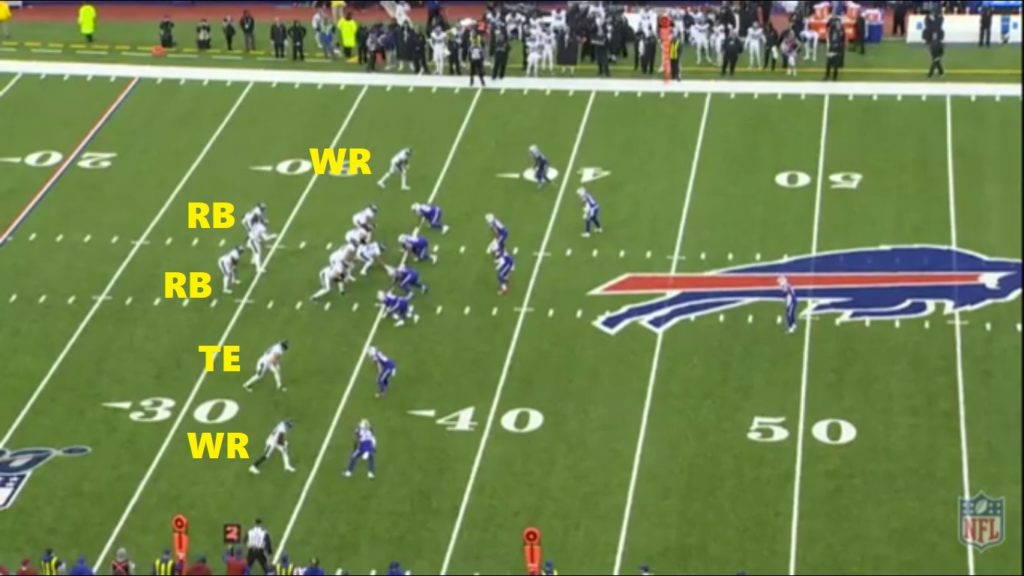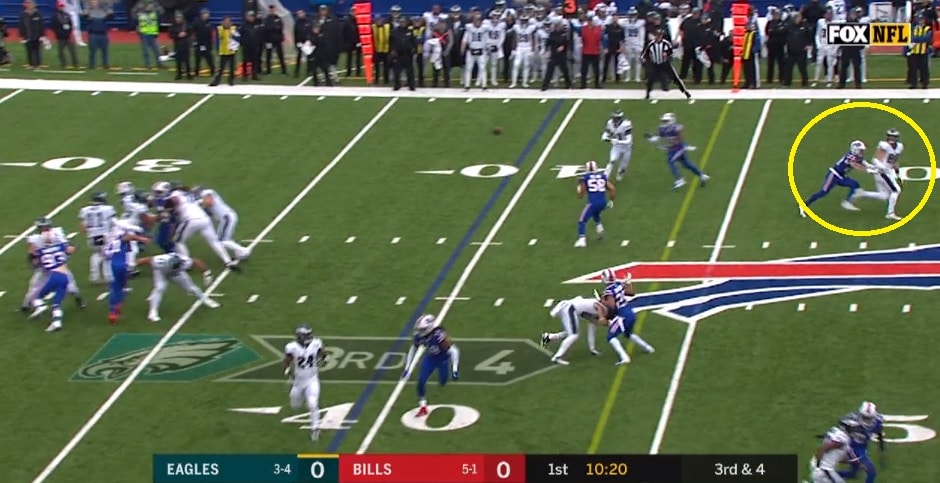Ad Disclosure
All 22 Film: Sluggo Adjustment, 21 Personnel, and Lead Blockers

Welcome to the weekly all-22 film article.
Today we’re gonna talk about two topics, one being an in-game adjustment after a first quarter incompletion, and the second is the series of 21 personnel and lead-blocker play calls Doug Pederson used on Sunday.
Right then, let’s get into it.
Topic 1:
The long completion to WR Alshon Jeffery down the left sideline, QB Carson Wentz explained that was an adjustment based off of something you guys saw in the first half. Can you explain what that adjustment was? (Bo Wulf)
HEAD COACH DOUG PEDERSON: Yeah, if you remember the second third down of the game, the ball was incomplete and knocked down. You saw Alshon — I think [Bills CB Levi] Wallace, knocked the ball down, so we remembered that and he remembered that. So we talked about what we wanted to do on a couple of plays that we had in the game plan, and had a chance to get to it there in the second half, second possession of the second half, and made that adjustment. We had talked through it, and well executed.
Here’s your refresher, the 3rd and 4 play call where Carson Wentz threw the a three-yard slant that Buffalo was all over:
With Wallace jumping the route on that play, the Eagles came back to Jeffery in the second half, held the single high safety with shotgun play-action, and turned that route into a slant-and-go, getting Wallace to bite and opening up some space down the sidelines:
Simple adjustment there. If the corner is bearing down on the slant, turn it into a sluggo and hit them for chunk yardage instead.
Topic 2:
Q. The Miles Sanders touchdown, where did that play come from? (Dave Zangaro)
HEAD COACH DOUG PEDERSON: [Offensive Line/Run Game Coordinator] Jeff Stoutland.
Q. Did he design it? Did he borrow it? (Dave Zangaro)
HEAD COACH DOUG PEDERSON: It’s actually a play that we have in our game plan, or I should say, we have in our run game plan. We’ve worked on it since OTAs. We’ve done it with tight ends. We haven’t done it with that personnel group. And so we worked on it this week in practice, and actually ran it once earlier in the game in the first half, and we threw the pass — which was the adjustment to that — to Alshon. It was incomplete. Came back in the second half, second play. Well executed. Great block by [RB] Jordan [Howard] and Miles did the rest.
Right, so they actually used this concept three times in the game.
The first play is 21 personnel, with Miles Sanders and Jordan Howard as split backs on either side of Carson Wentz. On this sequence, they tried to get Jeffery on a jump ball with a favorable matchup on the short side of the field:
Not Carson’s best pass, but you’ll typically take your bigger possession receiver on that type of quick hit any day of the week. Could have been a five or six yard gain and a first down if Wentz puts a little more air under it.
Another batch of quotes here, these regarding the 65 yard Miles Sanders touchdown run, which came out of the same exact formation:
Q. Because of that personnel group, is that a big reason why it worked, because it’s the first time that you’ve used it? (Nick Fierro)
HEAD COACH DOUG PEDERSON: Yeah, that and I just think, too, it was just our execution on that play is what we wanted. It’s a little bit of a misdirection from the standpoint of where the backs were crossing. But again, well blocked up front with the O-Line, Jordan on 58 [Bills LB Matt Milano] there and good run by Miles
Q. You mentioned Jordan Howard on that lead iso block. How about G Isaac Seumalo on that play? (John McMullen)
MIKE GROH: Isaac cleared out there. Yeah. He did. We cut the back side of the defense and did a great job. Really cut the defense in half. And then Andre [T Andre Dillard] on the play side did a great job of turning the defensive end out to make sure that he didn’t cross face. So we had a big hole there. It was well designed and well executed.
You’ve seen the replay, but here’s the coach’s film. Howard got a ton of credit for this block, as he should have, but Seumalo does a great job, as Groh said, of clearing out and allowing the lead back to get through the hole and engage at the second level:
And you see the Bills playing off a bit there, which made it easier for Jason Kelce to get up on his linebacker as well. They possibly could have recognized the earlier throw to Alshon from this formation and sat back in pass protection, thinking the Birds were gonna toss it instead.
Here’s final quote describing the third sequence of this progression:
Q. Did you like the two-back look as opposed to having the TE there because … (Jeff McLane)
HEAD COACH DOUG PEDERSON: The play was in both ways. I actually called the play three times. Twice with that personnel group and the third time with the tight end in the game and it was actually a positive run to Jordan as well. Again, it’s a well-executed play. I liked having the two [running backs] because right now teams are focusing on 26 [RB Miles Sanders] when he’s in the game as a receiver and this is a great way to get both our guys in the game and do a little bit of both.
This one I didn’t notice during the game.
It’s not 21 personnel, since there’s only one running back on the field, but what they do is sit Zach Ertz back a bit, not really as a split back, but just a yard off the line, and then they bring him through the hole as the lead blocker and let Howard carry the ball:
Nine yard gain on that play, which was similar to the Sanders run but deployed with a different personnel set.
I like this on a macro level because running back and tight end are two strengths of this team. If the wide receivers are just ‘meh,’ then getting creative with 21 personnel and using a tight end as a lead blocker or throwing passes out of that formation really does make a lot of sense.
Doug had one of his better play calling performances in the 31-13 road win, and this three-play series was a big part of that.
Kevin has been writing about Philadelphia sports since 2009. He spent seven years in the CBS 3 sports department and started with the Union during the team's 2010 inaugural season. He went to the academic powerhouses of Boyertown High School and West Virginia University. email - k.kinkead@sportradar.com
